Congratulations to Tony van der Weerden and DATAMAN colleagues for the JEQ 2023 Outstanding Paper!
- DATAMAN: A global database of nitrous oxide and ammonia emission factors for excreta deposited by livestock and land-applied manure https://doi.org/10.1002/jeq2.20186
DATAMAN is a global project, led by New Zealand, which was set up as part of the GRA Livestock Research Group’s Manure Management Network. The international team of researchers aims to develop a global database on greenhouse gas (N2O, CH4) and NH3 emissions from the manure management chain (housing, storage, and field) to identify key variables influencing emissions and ultimately to refine emission factors (EFs) for future national GHG inventories and NH3 emission reporting.
Learn more about DATAMAN here: https://www.dataman.co.nz/
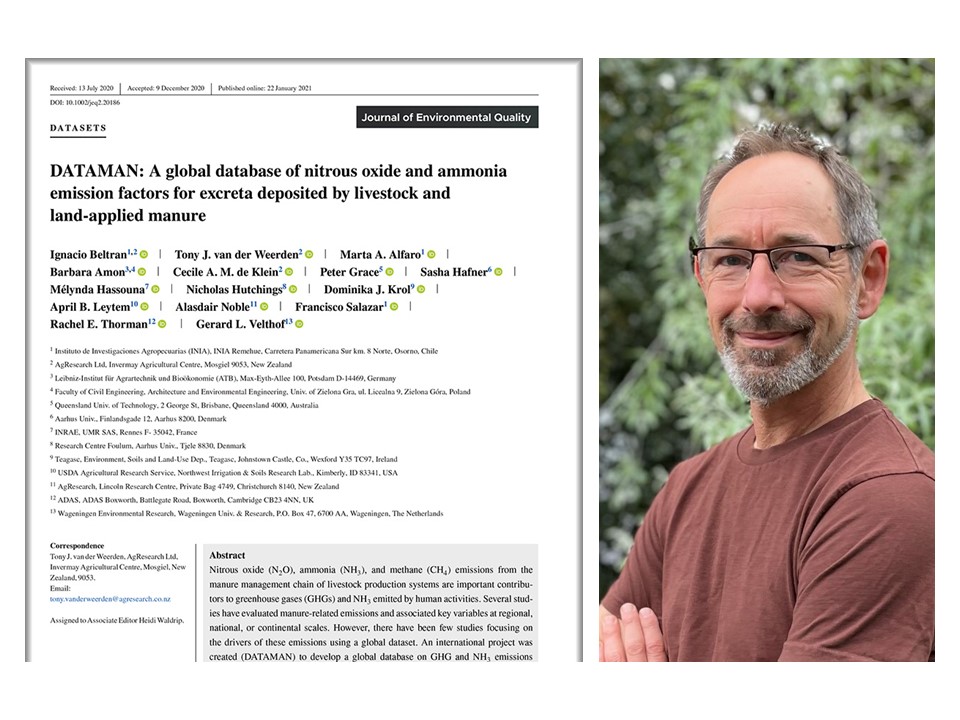
Closing date: 27 October 2023
Location: Canterbury, New Zealand
Project title: Green boundaries: Unleashing nature’s power to reduce greenhouse gas emissions in dairy farming
Are you passionate about sustainable agriculture, climate action, and soil science? Join us in an exciting PhD project focused on harnessing the potential of native vegetation along dairy paddock boundaries to combat greenhouse gas emissions, while simultaneously boosting biodiversity.
New Zealand’s dairy industry is both vital to the economy and a significant contributor to greenhouse gas emissions. Using the Lincoln University Demonstration Dairy Farm, we will investigate how “green” boundaries influence soil carbon stocks, nitrogen dynamics, soil microbial activity, and uncover the mechanisms behind these changes.
Specifically, the student will:
(1) Quantify how soil carbon stocks and microclimate factors change along native vegetation boundaries and into pasture;
(2) Test how use of these boundary areas as stock camp shelters may influence N2O emissions;
(3) Investigate the microbial mechanisms facilitating changes in carbon and nitrogen dynamics with distance from the native vegetation; and
(4) Calculate the total net reduction in GHG emissions within the pasture with the added native vegetation
Students interested in pursuing this project should have a prior degree in soil science, ecosystem ecology, biogeochemistry, agricultural sciences, or a related field. Ideal candidates should be comfortable conducting fieldwork, running laboratory experiments, and have some background in statistics, GIS, and/or computer modelling.
LEARN MORE & APPLY HERE.
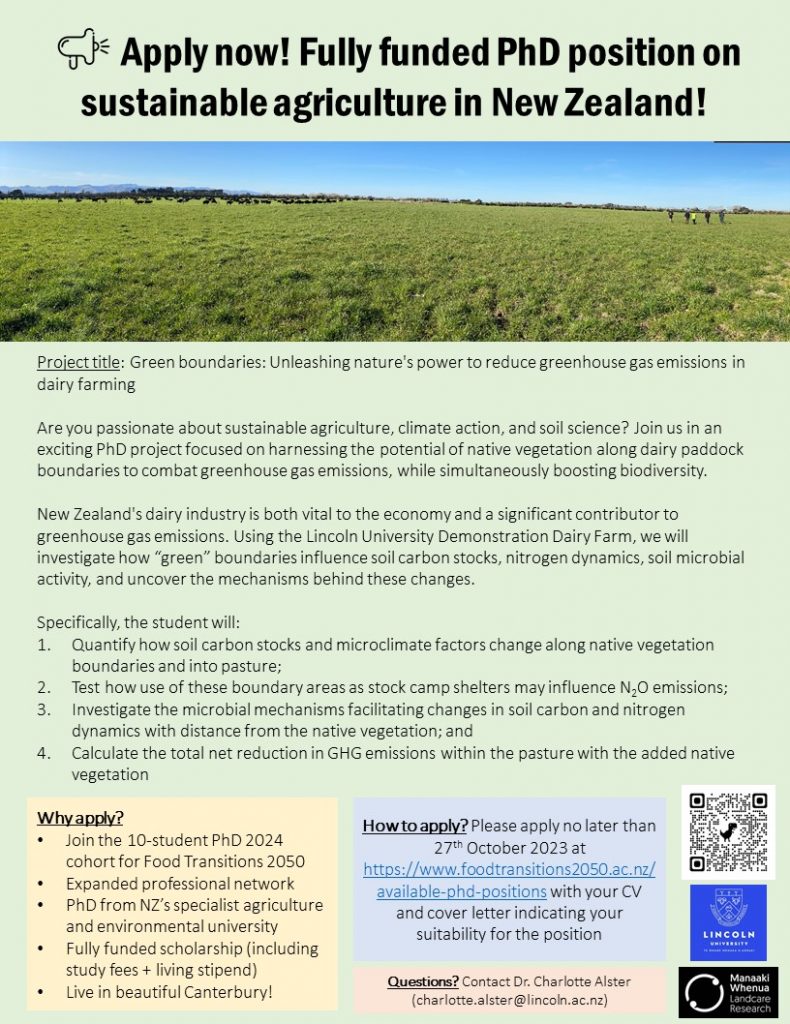
A recording of the Circular Food Systems Network webinar from 15th September 2023 titled “Indicators to measure circularity: developments & considerations” is now available to view here. The white paper introduced in the webinar, “Circular Food Systems around the world: exploring concepts, ideas and opportunities” can be downloaded here.
This webinar brought together experts to focus on the development and considerations of indicators to measure circularity. The following questions were discussed: can we measure circularity? How would we do that? What are the limitations of using indicators? Are there alternatives to measure circularity of a food system? How important is it to measure circularity – is it necessary or does it defeat the purpose of circularity in food systems?
The webinar included the following:
- Short introduction and presentation of the whitepaper ‘Circular Food Systems around the world’ – by Flavia Casu
- Three presentations of projects funded by the CFS Network
- Circularity in Integrated Systems: Resource Recovery for Feed, Fuel and (Organic) Fertilizer Self-sufficiency in Ethiopia – by Carlos Brazao Alho
- Benchmarking nutrient circularity at different scales: Using a food systems perspective – by Marloes van Loon
- A holistic framework for assessment of circular food systems – by Vicki Burggraaf
- Panel discussion with the project leaders to discuss (the need for) indicators (and possible alternatives) to measure circularity.
Closing Date: 27 September 2023
Location: NZAGRC, New Zealand
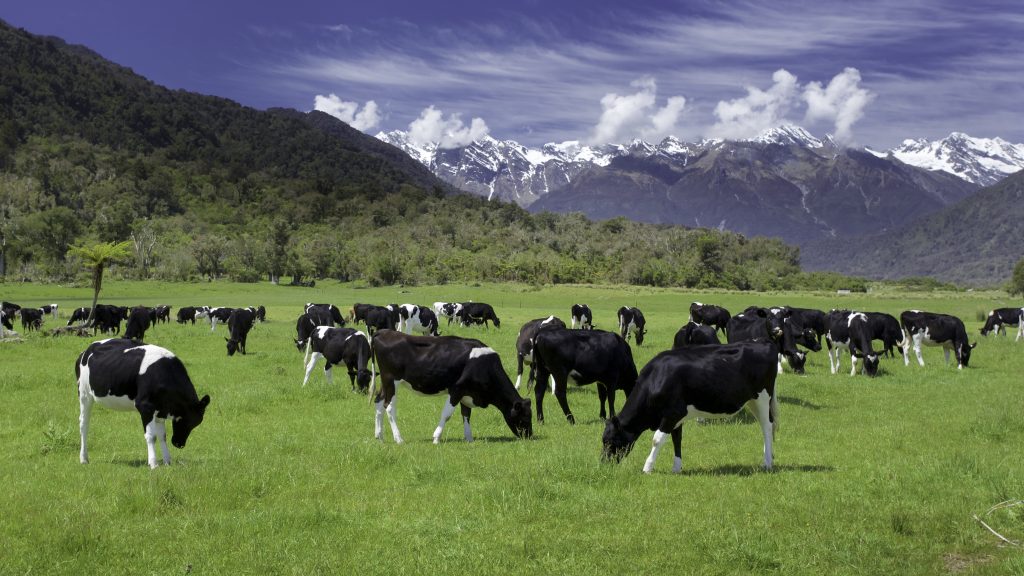
The New Zealand Agricultural Greenhouse Gas Research Centre (NZAGRC) is expanding due to increased investment and is seeking a Senior / Principal Science Advisor.
Working across international and domestic spheres, the role will be responsible for the elaboration of complex scientific research and development programmes focussed on reducing agricultural greenhouse gas emissions. The International role will support the NZAGRC Science Team to deliver on the vision and mission of New Zealand’s investment in the Global Research Alliance on Greenhouse Gases (GRA).
The NZAGRC is looking for someone with excellent scientific, communication and relationship skills and a strong familiarity with the workings of government departments and international science and policy fora.
(Note: Closing date extended from 20 September 2023)
An updated version of the GRA brochure is now available to download and share. Check it out here or by clicking on the image below.
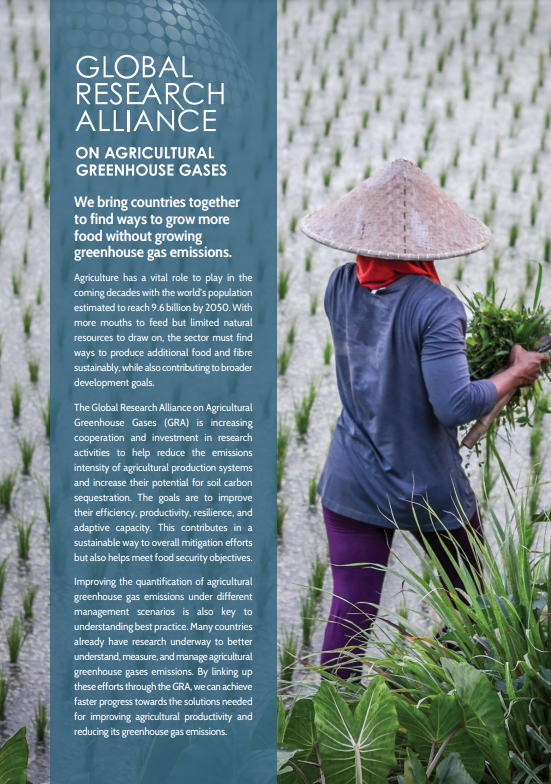
Preliminary call: Joint Colombia-NZ PostDoc project in Global Research Alliance Biological Nitrification Inhibition (BNI) programme
Overall aim: Understanding the key controlling points of BNI in tropical and temperate systems in relation to N2O emissions.

This 2-year PostDoc position for researchers from developing countries, is part of a collaboration with the Alliance Bioversity & CIAT (Colombia) and AgResearch (New Zealand) on the role of Biological Nitrification Inhibition (BNI) for reducing N2O emissions from livestock systems. The project is funded by the New Zealand Government in support of the objectives to the Livestock Research Group of the Global Research Alliance (GRA). The position is primarily based at CIAT campus, located in Cali, Colombia, but will be conducted in close collaboration with researchers in New Zealand.
The project focusses on identifying and quantifying the key control points of BNI in both tropical and temperate systems for maximising reductions in N2O emissions. It is an interdisciplinary project, involving plant, soil and systems scientists and will use the G x E x M framing to identify key genetic, environmental and management factors and their interactions.
The project will include conceptualisation of this framework, development, and meta-analysis of a quantitative database of information available in global BNI literature, and targeted experimental work to fill key gaps in the knowledge of controls of BNI effects on N2O emissions.
Register your interest for this position by completing the form HERE.
Closing date: 3 September 2023
Location: Technical University of Munich
See HERE and below for details.
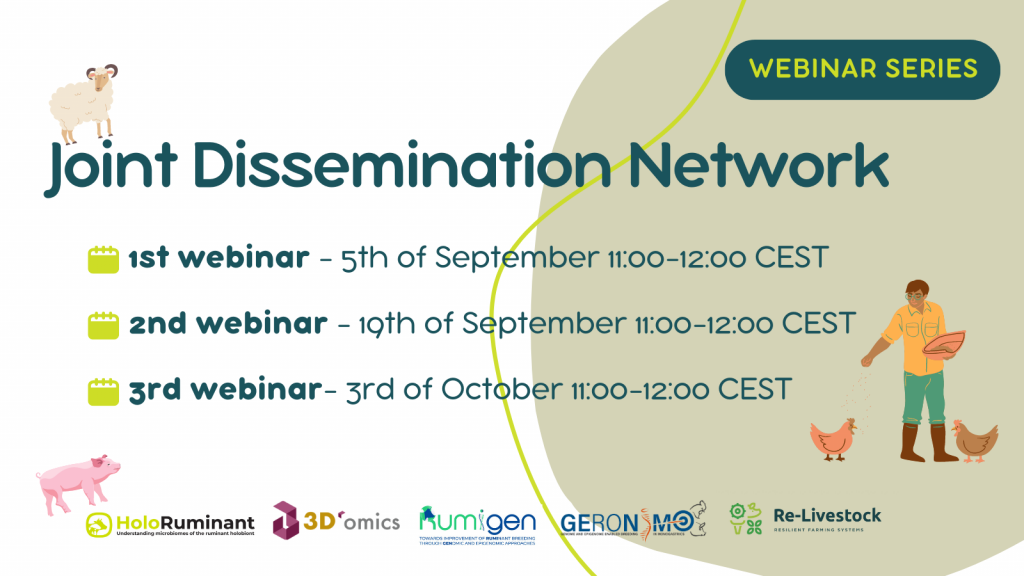
The HoloRuminant Joint Dissemination Network (JDN) consists of 5 projects representing a complementary effort to reduce the environmental and climate footprint of livestock production – while guaranteeing genetic diversity and efficient production in a more constrained environment – by focusing on the mitigation of GHG emissions improving the health and welfare of farmed animals and increasing the sustainability of animal production systems. The project group joins forces to provide an environment to optimize and share efforts.
The network will host a webinar series to showcase the different projects’ results. The series will include three sessions; the first will occur on the 5th of September, 11:00-12:00 CEST. In this session, they will be joined by:
Florence Bedoin and Elise Vanbergue (HoloRuminant): Stakeholders’ views regarding new practices to control microbiome; Birgit Gredler-Grandl & Oscar Gonzalez Recio (Re-Livestock): Animal breeding as a CH4 mitigation strategy and Jeremie Vandenplas (RUMIGEN: ” New breeding tools in a context of climate change”.
Registration details for all webinars can be found HERE.
The second webinar will be on the 19th of September (gut microbiome in monogastric), and the third and final (NGT for PLF traits) on the 3rd of October.
The August 2023 Issue of Who’s Counting, the Inventories and Nationally Determined Contributions (NDC) Network Newsletter is now available to view HERE.
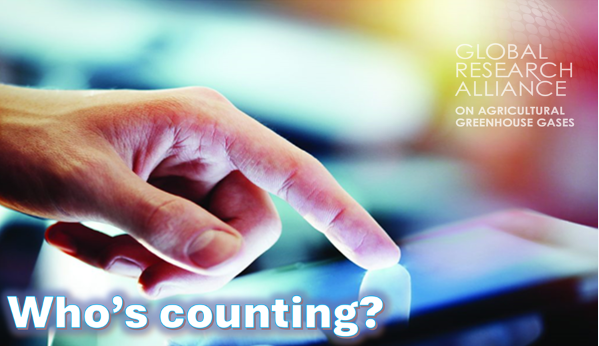
Who’s Counting summarises scientific progress, opportunities, resources and events related to national agriculture inventory development, national agriculture climate targets, and international inventory capability-building activities.
We encourage you to directly submit content for the next Issue of Who’s Counting, or contact one of the Inventories and NDC Network co-leads directly. To receive future issues of this Newsletter subscribe here.
Closing date: 31 August 2023
Location: Teagasc and University College Cork, Ireland
Teagasc PhD Walsh Scholarship Opportunity
“RU-MINIG: RUmen microbiome MINING for bacterial cultures to reduce methane”
Download the file below for details about the project and how to apply:
Manuscript deadline: 30 January 2024
Submissions are now open (Frontiers in Climate) for the following Research Topic: “Restoration and Management of Peatlands for Climate Mitigation: Unravelling Biophysical and Socioecological Drivers of Change”.
About this Research Topic
Mires and peatlands are the largest natural terrestrial carbon store. Though covering only 3 percent of the world’s land surface, they store approximately 20 percent of the global soil organic carbon stock or two times that of global forest biomass. In addition to their role in the carbon cycle, peatlands provide a multitude of ecosystem services, including provisioning (eg. fuel, fibre, food) water purification and nutrient retention, erosion protection, soil formation, recreational and educational services, as well as harboring of unique biodiversity. Over the past century, about 15% of peatlands have been drained, mainly for agriculture and forestry. Peatland drainage leads to rapid soil degradation, soil carbon loss and nitrogen mobilization, land subsidence, as well as loss of the various other valuable ecosystems service that in-tact peatlands provide.
Globally, efforts to restore previously drained and degraded peatlands, primarily through rewetting, have increased in the last few decades. Peatland rewetting, as a nature-based solution to global climate change, reduces land subsidence, carbon loss, and risks of peat fires and has the potential to turn carbon sources back to sinks. Yet many of the biophysical processes are not well-resolved, such as the impact of drainage or rewetting on the magnitude of difference in production and consumption of greenhouse gases, as well as other biogeochemical processes and the involved microbial communities. Furthermore, rewetting of highly degraded peatlands may promote the mobilization of dissolved organic carbon, nitrogen, and phosphate which can cause eutrophication. Prompt rehabilitation of degraded peatlands, while imperative, requires the consideration of multiple stakeholders’ interests. Thus, in addition to biophysical processes, socioeconomic and political considerations also need to be a part of the decision-making process. Therefore, this research topic focuses on unravelling biophysical and socioecological drivers of change in drained and rewetted peatlands to enable better restoration and management of peatlands for climate benefits as well as co-benefits.
The scope of this research topic includes:
• Peatlands and their role in adapting and mitigating climate change
• Peatland conservation, restoration, and sustainable management (climate-focused)
• Peatlands and carbon sequestration
• Peatland protection in climate action plans
• Peatlands and Eutrophication
• Stakeholder engagement in peatland conservation
Submissions on tropical peatlands are highly encouraged. Submissions on all types of manuscripts will be considered which includes: Original Research, reviews, perspective, case report, community case study, data report, policy brief, general commentary, opinion, technology, and code.
The July 2023 Circular Food Systems Network (CFS) Newsletter is now available online!
In this edition you can find information about upcoming events, interesting open access publications, a call for examples of circular food systems in Europe, and more!
You can read the newsletter HERE.
If you’d like to subscribe to receive future CFS Newsletters, sign up here.
